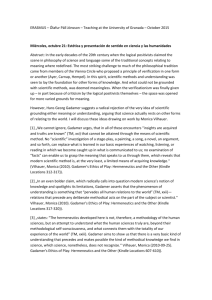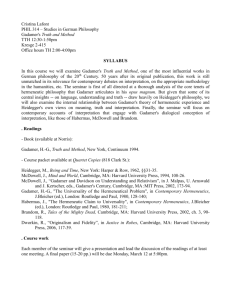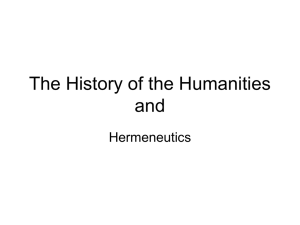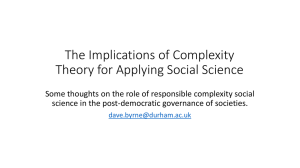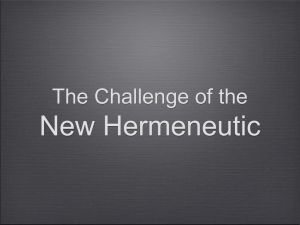Are Hermeneutics and the Austrian Approach Compatible? A Clarifying Analysis
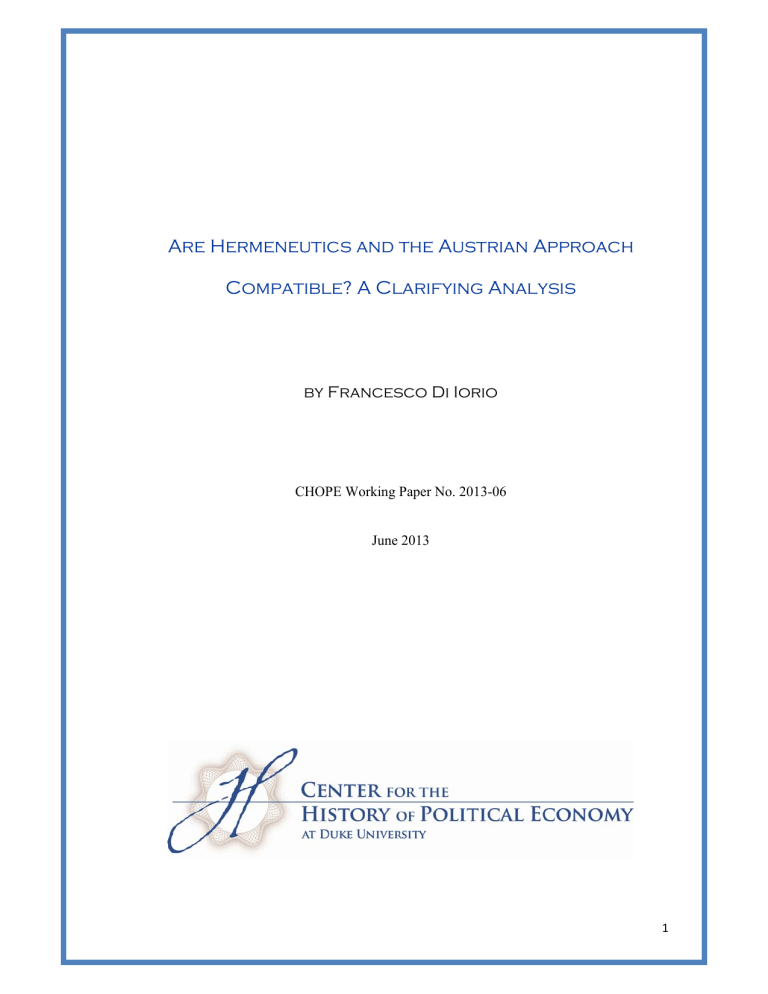
Are Hermeneutics and the Austrian Approach
Compatible? A Clarifying Analysis
by Francesco Di Iorio
CHOPE Working Paper No. 2013-06
June 2013
1
Are Hermeneutics and the Austrian Approach
Compatible? A Clarifying Analysis
Francesco Di Iorio
ABSTRACT
This paper investigates the merging of the Austrian Approach and Hermeneutics under a new light. It defends a middle ground between the standpoint of the Austrian hermeneutists and that of their critics. The latter, especially Rothbard, considered hermeneutics to be incompatible with Austrian School because they confused hermeneutics with what Mises calls
“polylogism”, i.e. with cognitive nihilism. Their view was incorrect, but their criticism of the
Austrian hermeneutists was not completely unfounded. Austrian hermeneutists did not clearly separate what they called hermeneutics from the postmodernist epistemologies of authors such as Derrida, Kuhn, and Rorty. This article demonstrates that hermeneutics as intended by
Gadamer, its greatest theorist, has nothing to do with postmodernism. It is a fallibilist theory of the objective truth in the sense of Popper. So it is compatible both with the Austrians’ antipolylogism and their methodological individualism.
Keywords: Austrian School, Hermeneutics, Postmodernism , Gadamer, Popper.
1.
Introduction
It is well known, beginning in the 1970s there has been an attempt to merge the epistemology of Austrian School and hermeneutics. Ludwig
Lachmann and, after him, Lavoie, Ebeling, and other scholars tried to show the heuristic utility of this marriage. Their attempt to merge the epistemology of Austrian School and hermeneutics has sometimes been strongly criticized (See, in particular, Rothbard 1989). Unlike Rothbard, we will assume that merging Austrian school and hermeneutics is worthy.
However, we will partly criticize the Austrian hermeneutists by arguing that sometimes their works created confusions preventing an accurate understanding of the connections between hermeneutics and Austrian approach.
2
As intended by Gadamer, its greatest theorist, hermeneutics is both an anti-holist and anti-sceptical standpoint. If understood in these terms, hermeneutics matches up well with the Austrian approach and is useful for enriching the Austrian theory of action. However, many Austrian hermeneutists did not seem to understand hermeneutics in these terms.
They did not clearly separate what they called hermeneutics from the postmodernist epistemologies of authors such as Derrida, Kuhn, and Rorty.
Unlike Gadamer, postmodernists defend what Mises (1998) calls polylogism. They deny the existence of a transcultural truth and consider rationality to be variable depending on the social environment. Due to this fact, they do not really defend an interpretative approach, but are cryptoobjectivist. Like the Positivist sociologists, they assume that the environment controls individual minds. Consequently, their views are incompatible not only with the Austrian theory of science, which rejects the idea that truth is culturally relative, but also with the Austrian methodological individualism. As Boudon (2005) has clearly showed, since methodological individualism criticizes social determinism, postmodernists are not methodological individualists, but holists.
Following Gadamer, it is easy to show that Rothbard was wrong in assuming that hermeneutics is relativism and nihilism. However, many
Austrian hermeneutists were wrong as well due to their dalliance with postmodernist scepticism. Today the connections between hermeneutics and Austrian School are rarely explored which in part is most likely due to the fact that many Austrian hermeneutists did not separate themselves from postmodernism.
As we will try to demonstrate, like the old theory of textual interpretation, philosophical hermeneutics as intended by Gadamer, is not scepticism and cognitive relativism, but a fallibilist theory of the objective truth. In order to clarify this point we will compare Gadamer’s conception of knowledge and Popper’s epistemology. Unlike the majority of current authors, we argue that these two thinkers share a very similar standpoint.
During the last years of their lives, both acknowledged the similarities between their views. Focusing on these similarities, we will maintain that the project to merge Austrian and Hermeneutics is worthy insofar as the confusion between hermeneutics and postmodernism is avoided.
3
The article is organized as follows. Section 1 explains the concept of
Philosophical hermeneutics by analysing its history. Gadamer argued that a concept cannot be understood without considering its temporal development. Understanding the history of hermeneutics is necessary to understand Gadamer’s view. Section 2 shows that Gadamer, unlike the postmodernists, is not a cognitive relativist. Namely, this section explains why Gadamer’s theory of interpretation and Popper’s method of trial and error are very similar outlooks even though they are often assumed to different. Section 3 deals with the connections between hermeneutics and the Austrian school. It provides a partial criticism of the Austrian hermeneutists together with a partial criticism of their opponents. The idea that Hermeneutics and the Austrian school are compatible approaches and can be fruitfully merged is explained on the basis of the analyses developed in section 1 and 2.
1.
The Evolution of Hermeneutics from Science of Textual
Interpretation to Philosophy of Knowledge
As traditionally defined, hermeneutics is “the art of interpretation” (Lawn
2006, p. 44). The word hermeneutics is derived from “the Greek term hermeneuein , meaning to interpret” (p. 45). As Moran (2000, p. 271) underlines, in Greek mythology, Hermes – the name is associated with hermeneuin – “was the messenger of the gods, a go-between gods and humans, who tells lies as well as truths, who misleads as well as leads”.
Because they were ambiguous, his speeches needed to be interpreted, and their meaning was controversial. Thus, for the Greeks, “interpretation was the elucidation and explanation of elusive sacred messages and signs”
(Lawn, 2006, p. 45).
After the Greeks, it was the Protestant theologians of the seventeenth century who took the next significant step in developing what we today regard as hermeneutics. Protestant theologians wanted Protestants to understand God’s ways; they wanted to provide translations of the Bible that could be understood and welcomed by everyday people. To do that, they “devised hermeneutica ” (Lawn, 2006, p. 45; see also Crotty 1998, p.
88-90), a science for studying the general principles of textual
4
interpretation and good translation. Although this discipline – usually known as “classical hermeneutics” – starts to be called that only during the seventeenth century, its origins are in the Middle Ages, when various authors constructed a methodological framework for the interpretation of biblical, legal and classical texts (see Grondin 2008, p. 5-6). Classical hermeneutics is strictly linked to rhetoric , the study of argumentation and persuasion (see Gadamer, 1981, p. 123). It takes from the latter many of its principles and rules. For instance, this is the case for the original version of the so-called ‘hermeneutical circle’, according to which the “whole is to be understood in the relationship to the parts, and the parts the whole” (Lawn
2006, p. 47; see also Grondin 2008, p. 11). This principle is strictly linked to other interpretative guidelines, which are applied by the hermeneutists, such as the rule according to which the meaning of a word or statement has to be assumed as depending on the context; or the rule that affirms that a mind which understands a meaning is not an empty mind, but a mind interpreting the text in the light of shifting a priori – in the light of a horizon which changes as one progresses in reading the text.
During the Romantic Era, the hermeneutical tradition starts to “move from textual interpretation to the more general question of the nature of understanding” (Lawn, 2006, p. 46). The key figure in this “change”
(Gadamer, 2006, p. 175) is the German philosopher and theologian
Friedrich Schleiermacher (1768-1834). He concludes that hermeneutics is applicable not only to texts, but also to all other manifestations of human life, that is, “to all forms of interpretation” (Lawn, p. 46; see Grondin 2008, p. 6, 20).
After Schleiermacher, his attempt to extend the hermeneutical task is carried on especially by his biographer and follower Wilhelm Dilthey
(1833-1911). The latter uses the hermeneutical tradition and its philosophical implications to oppose the development of the scientistic and holist sociology. Especially in his early works, Dilthey takes issue with holist sociology by arguing that to understand human behavior, actions must be regarded as texts that need to be interpreted. The German philosopher rules out the possibility that human actions are the mechanical effect of social or historical laws which unconsciously control agents and undermine their autonomy. According to Dilthey, what determines the
5
dynamics of the human world are meanings existing inside human minds rather than causes acting on the individuals from the outside. He defends
“human freedom” (Gadamer, 2006, p. 202) and devises an interpretative sociology that anticipated and partly inspired the works of scholars like
Georg Simmel (1858-1918) and Max Weber (1864-1920). Dilthey also argued that there is a strong and irremediable difference between the interpretative method of the social sciences and the causal approach of the natural sciences – a thesis which, as we will see later, is in many ways not shared by the late Gadamer.
Another philosopher who has contributed – at least indirectly – to such an extension of the interpretative approach to the analysis of human action is Edmund Husserl (1859-1938) (See Gadamer 2006, p. 234-241).
As is well known, Husserl is the father of phenomenology, a philosophical theory which studies the features of consciousness. Phenomenology rejects objectivism, the positivist thesis that science studies neutral and given data.
In Husserl’s opinion, this thesis is wrong because it does not consider the implicit presuppositions of experience. For him, the theories of science are based on tacit knowledge, which is prior to them and builds the world of our consciousness, meaning that tacit knowledge constructs the way things are intuitively and immediately given to us (Gallgher & Zahavi, 2008, p.
19; 24; Petitot and al. 1999, p. 1 ff.). Husserl thinks that the metaconscious presuppositions of explicit and reasoned knowledge consist in an interpretative and selective process – a process which is linked to variable contextual and temporal horizons of expectations, including our cultural framework. Consequently, he uses an hermeneutical approach to understand the construction of the phenomenal world, to the way things immediately appear to us (see Gadamer, 1997, p. 130-181; Moran, 2000, p.
60 ff.).
Husserl’s pupil Martin Heidegger (1889-1976) is a key figure in the history of the evolution from classical or textual hermeneutics to philosophical hermeneutics. While Husserl applies the interpretative procedure to the analysis of consciousness by stressing the implicit and temporal presuppositions of the phenomenal world, Heidegger comes to the more radical conclusion that being itself, life under all its aspects, is temporality and interpretation (Gadamer, 2004, p. 247-248). He does not
6
merely devise a method to disclose and understand the implicit basis of experience, but elaborates a philosophy of “the original characteristic” of human existence (p. 250). Developing Husserl’s perspective, Heidegger investigates no less than the meaning of life. He comes to the conclusion that life consists in a continuous reworking of projects and constant interaction with changing situations and contexts. Consequently, he points out that life is a ceaseless understanding (or interpretation) in the light of a shifting and relative standpoint – an understanding which involves first and foremost practical or intuitive abilities, meaning a know-how more than a known-that (see Westphal 2008, p. 419-426; Crotty, 1998, p. 97-100). In addition, Heidegger emphasized more than Husserl that the ineradicable temporality of our knowledge implies our finitude, i.e. the impossibility to attain ultimate and absolute certitudes and truths (see Gadamer, 2006, p.
244 ff.; Lawn, p. 53-58). According to Heidegger, for the human being the only real certitude is death. In this sense, his hermeneutical analysis of the human condition is pessimistic, unveiling the agonizing aspects of life (see
Grondin, 2002, p. 31-51; 2006, p. 28-29).
His pupil Hans-Georg Gadamer (1900-2002) does not share such a pessimistic outlook, but he takes up and develops many aspects of
Heidegger’s thought. He devises in a more detailed way the principles of philosophical hermeneutics and makes the concept known around the world. Like Heidegger, Gadamer criticizes the positivist myth of the Given in particular, as well as the idea that knowledge may start from nothing – from a mind which is a tabula rasa filling up with theories through naive observations – as it is generally asserted by inductivism .
Following his master, he investigates and endorses the idea that man is basically an interpreter who is linked to a historical perspective – a perspective which is continuously shifting. Its variability, he argues, depends both on the fallibility of our empirical knowledge and the temporal relativity of the metaphysical preconditions of it (as, for instance, value choices). Due to this fact, Gadamer affirms, in accordance with Heidegger, that man is a historically finite being. However, contrary to Heidegger, he does not develop an existential hermeneutics. He is more concerned with purely epistemological problems than with the meaning of life. In particular, he applies Heidegger’s approach (or a part of it) to rethink and improve
7
Dilthey’s hermeneutical analysis of the methodology of the social sciences
(Grondin, 2002 p. 49-50; 2006, p 48-49; see also Dostal 2002, p. 247 ff.).
3. Gadamer and Popper: The Non-Arbitrary Nature of Understanding
The later Gadamer distances himself from Dilthey’s radical methodological dualism and endorses Popper’s view. He argues that the positivistic image of the natural sciences – an image which Gadamer supported in Truth and Method and which is usually considered as a correct description of the method of the natural sciences by the standards of dualist epistemologies – is actually wrong.
More precisely, the later
Gadamer (1985, p. 495) acknowledges that the way in which philosophical hermeneutics conceives the process of knowledge acquisition is not incompatible with Popper’s anti-positivist theory of science. This fact has been highlighted by the Viennese philosopher as well. According to
Popper (1980, p. 353), the way Gadamer describes the process of knowledge acquisition is merely the method of trial and error as intended by fallibilism – a method which is also shared by the natural sciences. The traditional tendency of the theorists of hermeneutics to defend a dualist approach, he points out, is precisely the result of their own mistaken view of the scientific method, i.e. of the fact that they implicitly and uncritically accept positivism as the only philosophy appropriate for the natural sciences (p. 353).
Within the theory of interpretation, the hermeneutic circle is the process is the process by which we understand a text. According to
Gadamer’s version of it, a text is a very large concept, referring not only to written words, but also, for instance, to artworks, theories, and human actions. The first systematic analysis of the analogy between Popper’s trial and error method and Gadamer’s theory of the hermeneutic circle has been developed by Antiseri (1981, p. 159-276). In Antiseri’s opinion, the approaches of Popper and Gadamer precisely “refer not to two different procedures but to the same one (and this, despite the differences in
“parlance” used to describe each)” (2006, p. 34). More recently, this view has been defended by other scholars as well (see, in particular, Di Nuoscio
2004, p. 93-106; Grondin 2003, p. 454). It is significant that also Albert
8
(1994. p. 48-49), who previously strongly criticized Antiseri’s position, finally ended up acknowledging the existence of undeniable similarities between Gadamer’s and Popper’s perspectives. Following Antiseri, it is possible to quickly stress the following points.
According to Popper, knowledge does not presuppose an empty mind. For him, we belong to a tradition. “Without tradition”, he holds,
“science would be impossible…Knowledge cannot start from nothing”
(Popper 2004, p. 36). In particular, the Austrian philosopher assumes that science begins when expectations, which are derived from past experience, are disappointed.
Science “always begins…with problems” (Popper 1994, p. 155) – problems arising when a conflict between expectations and experience occurs. The scientific method, he argues, can be summarized by three words: problems, conjectures, refutations. To put it in another way, it
“can briefly be described as follows. Faced with a certain problem, the scientists offers, tentatively, some sort of solution: a theory. This theory science accepts only provisionally, if at all; and it is most characteristic of the scientific method that scientists will spare no pains to criticize and test the theory in question. Criticizing and testing go hand in hand”
(Popper 2004, p. 313).
Testing the theory proceeds by exposing its
“vulnerable points to as severe examination as possible…Theories are put forward tentatively and tried out. If the outcome of a test shows that the theory is erroneous, then it is eliminated; the method of the trial and error is essentially a method of elimination.”
( Ibid .)
This approach allows access to an objective knowledge – meaning by
“objectivity…nothing other than controllability of proposed hypotheses”
(Antiseri 2006, p. 41).
9
Let’s consider now Gadamer’s work. According to Gadamer, the interpreter of a text, Antiseri (p. 42) states, does not read it with a mind similar to a tabula rasa , but with his own set of preexisting understandings,
“i.e. with his own prejudices, his presuppositions, his expectations”. A
“person who is trying to understand a text”, Gadamer (2006 p. 269) argues,
“is always projecting…a meaning”. With a given text, and a given “precomprehension” of such a text on the part of the interpreter, the interpreter sketches out a preliminary ‘meaning’, a “fore-projection.” This sketch is possible precisely because the interpreter’s mind is not empty, but it is endowed with “specific expectations which are the fruit of his own precomprehension” – a pre-comprehension depending on the interpreter’s a priori categories which are linked to what he knows and the tradition or history to which he belongs (Antiseri 2006 p. 42). For Gadamer (2006, p.
269), this preliminary meaning, this “fore-projection…is constantly revised in terms of what emerges as he penetrates into the meaning”. Every
“revision of the fore-projection is capable of projecting before itself a new projection of meaning; rival projects can emerge side by side until it becomes clear what the unity of meaning is; interpretation begins with fore-conceptions that are replaced by more suitable ones. This constant process of new projection constitutes the movement of understanding and interpretation.”
( Ibid .)
Therefore it becomes evident that it is clearly trial and error which is at work here. During this interpretative process problems inevitably do arise. A person who is trying to understand is exposed to errors
“from fore-meanings that are not borne out by the things themselves. Working out appropriate projections, anticipatory in nature, to be confirmed ‘by the things’ themselves, is the constant task of understanding”
(p. 270).
10
The problem of interpretation is to disclose an empirical truth (see
Taylor 2002, p. 126 ff.). The interpreter needs to tests his hypothesis by considering both the text and the context (as context one may consider, for instance, the historical situation in which the text was written, the evolution of the language, the life of the author, and so on). The hermeneutical activity”, Gadamer maintains, seeks “objectivity”, i.e.
“the confirmation of a fore-meaning in its being worked out.
Indeed, what characterizes the arbitrariness of inappropriate foremeanings if not that they come to nothing in being worked out? But understanding realizes its full potential only when the fore-meanings that it begins with are not arbitrary. Thus it is quite right for the interpreter not to approach the text directly, relying solely on the fore-meaning already available to him, but rather explicitly to examine the legitimacy
– i.e., the origin and validity – of the fore-meanings dwelling within him.”
(p. 270).
Like classical hermeneutics – which attempted to define the criteria for the correct and objective interpretation of a text – Gadamer’s philosophical hermeneutics is incompatible with cognitive skepticism.
Arguing that it is possible to establish a valid interpretation of a text, it defends the objectivity of truth. It acknowledges that we can understand what is empirically correct. “Meanings cannot be understood in an arbitrary way” (Gadamer 2006, p. 271). We “cannot stick blindly to own our fore-meaning about the thing if we want to understand the meaning of another” ( Ibid .). Meanings
“represent a fluid multiplicity of possibilities…, but within this multiplicity of what can be thought – i.e., of what a reader can find meaningful and hence expect to find – not everything is possible”
( Ibid.
).
11
In other words, meanings are not purely subjective:
“a person trying to understand a text is prepared for it to tell him something. That is why a hermeneutically trained consciousness must be, from the start, sensitive to the text’s alterity”
( Ibid .).
4. Hermeneutics and the Austrian School
Ludwig Lachman has underlined that the Austrian school’s methodology of the social sciences can be considered to be a particular manifestation of an older and larger interpretative tradition due to its criticism of scientism and sociological holism. Lachman especially focused on the links between this tradition and the Austrian theory of action. “Characteristic of the trend of the Austrian school”, he writes, “is, in our views, Verstehen
(understanding), introduced as a method into the theoretical social sciences” (Lachmann, 1977, p. 47). Such a method, he points out, “has, as is well known, a long and glorious history” (p. 47) – a history which starts with the development of hermeneutics, the science of textual interpretation.
According to Lachmann (2007, p. 20), the basic foundation of the Austrian school’s methodological individualism
“is nothing more than the classical method of interpretation applied to overt action instead of to texts, a method aiming at identifying a human design, a “meaning” behind observable events.”
As earlier affirmed, criticizing methodological holism and assuming the cognitive autonomy of the actor – i.e. his or her intentionality – are required for the analysis of society in terms of unintended consequences.
Like Lachmann, others scholars, such as for instance Don Lavoie and
Richard Ebeling, have equally underlined this connections between hermeneutics and Austrain methodological individualism. In particular, these two authors, as well as their followers, tried to merge Austrian
12
economics with representatives of contemporary hermeneutical philosophy such as Heidegger and Gadamer (see, for instance, Lavoie 1991, p. 1-14).
As Boettke (1990, p. 36) – one of Lavoie’s pupils – affirms, Hayek and the
Austrian School developed an interpretative approach against the objectivist views in the social sciences and the thesis according to which
“ man had to be purged from the analysis”. This interpretative approach is also called methodological individualism precisely because it presupposes that action is not a mechanical effect of the material or social context but the consequence of the way individuals interpret their environment and the problems they have to overcome. To explain an action means to consider its meaning. This is the first step to “understand[ing] the diverse patterns of actions that make up the social world” (p. 41).
A similar standpoint has been developed by Koppl. Koppl investigates the connections between Hayek’s theory of the sensory order and hermeneutics. He stressed that Hayek’s theory of mind implies the use of a hermeneutical approach in the social sciences. Boettke (1990, p. 40) and Lavoie, Baetjer, and Tulloh (1990) agree with Koppl on this point.
According to Koppl (2008, p. 118), one of Hayek’s great achievement was to bring the theory of complexity “and interpretation together” Hayek,
Koppl ( Ibid .) writes,
“used a set of very carefully developed scientific arguments about complexity and neuroscience to show that logically necessary limits of our knowledge of minds like our own require us to rely on…hermeneutics”.
These limits imply that the social sciences cannot be based on the assumption of a contextual determinism, but have to be founded on the
“interpretation of human meanings” (p. 118). Koppl (p. 105 ff.) regards classical hermeneutics and Dilthey’s work. However, he is not enthusiastic about Gadamer’s phenomenological hermeneutics. He is rather doubtful about the compatibility between Gadamer’s hermeneutics and the scientific method. Moreover, following Dilthey, he defends methodological dualism.
Consequently, some of Koppl’s ideas are incompatible with the standpoint that is defended in this paper.
13
Two eminent critics of the idea that hermeneutics and the Austrian approach can be merged are Caldwell and Rothbard. Caldwell acknowledges the relevance of interpretation within the Austrian epistemology. For instance, he stresses that Hayek’s theory of mind implies the idea that all knowledge is interpretation (2004, p. 247). He maintains, as do Boettke, Koppl and, Lavoie, that Hayek attempted to use his theory according to which the nervous system is a complex phenomenon “to build a case for a subjectivist approach in economics”
(Caldwell 2007, p. 260). Caldwell (p. 271) also points out that if Hayek’s theory of mind is correct, “selection, evaluation, and interpretation take place at every step in the creation of the sensory order”. According to him, for the Austrian author, every act of categorization “is…an act of interpretation” (p. 271) and “all observation is theory laden” (p. 254).
However, although Caldwell agrees with Hayek’s anti-positivism, he is wary of Hermeneutics. More specifically, he considers hermeneutics as incompatible with Hayek’s theory of science especially in Hayek articulated it in his later works – a theory which is, he contends, antidualist and anti-relativist (Caldwell 2004, p. 249). Caldwell (2007, p. 260) argues that the way hermeneutics handles interpretation is not completely compatible with Hayek’s defence of the objectivity of scientific truth. For
Caldwell (1994, pp. 308-311), hermeneutics means postmodernism and scepticism and Hayek’s “dalliance” with Popperian thought is proof of the incompatibility between his view and that of hermeneutics.
Caldwell’s analysis can be criticized. As we have earlier mentioned, hermeneutics – and, in particular, Gadamer’s conception of it – is not a type of scepticism, but a fallibilistic view of knowledge, which is compatible with Popper’s anti-positivistic theory of the unified method – a theory which defends the idea that the natural and human sciences share the same approach not in the sense positivists believe, but in the sense fallibilism and critical rationalism assume. However, However, Caldwell’s criticism of the attempt to merge the Austrian approach with hermeneutics is partly understandable. As we have already pointed out, many Austrian hermeneutists seem to argue that hermeneutics is a nihilistic and sociorelativistic conception of knowledge. Their position has probably been at least partly influenced by a misleading interpretation of hermeneutics that
14
seems quite common among North American philosophers. According to this misleading interpretation (which is sometimes called “interpretative turn”), the “hermeneutics” label practically describes any orientation admitting that observation is theory laden. By reading some of the articles or collective works which have been published by the hermeneutical
Austrians one can see that Gadamer’s position is assumed to be basically similar to that of disparate authors, including socio-historical relativists like Kuhn, Derrida and Rorty.
For instance, Madison (1989, p. 177-178) curiously maintains that the similarity between Hayek and Kuhn’s points of view proves that the former is a follower of the hermeneutical theory. Actually, Kuhn’s polylogism and irrationalism are incompatible both with Hayek’s and
Gadamer’s thought. Namely, they are not consistent with Hayek’s theory of science and his methodological individualism (see chapter 5: see also
Boudon 2004; Di Nuoscio 2004). Moreover, Madison (1989, p. 177) also affirms that both the Hayekian and the hermeneutical approaches are fundamentally different from Popper’s “revised…version of positivism” – an epistemology which, for Madison, considers a theory as scientific only if it can ensure a perfect and detailed quantitative forecasting. This is patently untrue.
By failing to clearly distance themselves from the post-modernist skeptical philosophy, the Austrian hermeneutists have been violently criticized by Rothbard and his followers.
Due to what we have said above, this criticism, like Caldwell’s, is partly comprehensible. Rothbard’s radical aversion to hermeneutics is also linked to the fact that, unlike Caldwell, he endorses an epistemology denying that knowledge is interpretation and arguing that we are able to know absolute and indisputable truths. In other words, he follows an essentialist and foundationalist approach which is radically incompatible with both hermeneutics and fallibilism. In any case,
Rothbard is wrong when he maintains that hermeneutics is an orientation arguing that no objective truth can be found and defended. He points out that
15
“the essential message of…hermeneutics can be…summed up as nihilism, relativism, and solipsism. That is, either there is no objective truth or, if there is, we can never discover it”
(Rothbard 1989, p. 45).
This view must be rejected. As Antiseri (2011, p. 89) underlines,
Rothbard’s standpoint is nothing but a “wrong interpretation of the theory of interpretation”.
5. Conclusion
We tried to defend the possibility of merging hermeneutics and the
Austrian approach by stressing, unlike many Austrian hermeneutists, that hermeneutics must not be confused with the postmodernist epistemologies.
By focusing on the similarities between Gadamer’s theory of knowledge and Popper’s epistemology, we have proposed a middle ground between the standpoint of many Austrian hermeneutists and that of their critics.
Philosophical hermeneutics is useful for enriching Austrians’ methodological individualism because it helps us understand the interpretative presuppositions of action. Let us consider an example.
Mises’ tautological theory of the culturally invariable structure of action and Gadamer’s theory of the hermeneutical circle are both incompatible with the holist paradigm of cultural incommensurability, i.e. with polylogism (see Di Nuoscio 2011). However, Mises and Gadamer criticize cultural incommensurability from a different angle. Unlike Gadamer,
Mises carefully clarified the nature of the logical invariable categories of action. On the contrary, unlike Mises, Gadamer carefully clarified the empirical process that enables us to understand the others – a process that he calls “fusion of horizons”. Gadamer (2006, p. 305 ff.) explains that people who belong to a different culture than ours can be understood not only because action is based on culturally invariable presuppositions, but also because our specific cultural horizon is a temporally shifting horizon.
According to Gadamer, since our horizon is not a fixed and unchangeable
16
standpoint, by interacting with people who do not share our cultural background, we can acquire new meanings and learn to interpret these people. For instance, if we do not speak their language, we can slowly learn to understand it. So, unlike Mises, Gadamer focused on the nature of the cultural differences and clarified why cultural differences are not barriers that prevent us from understanding others. Gadamer argues that this is a crucial reason why the fusion of horizons (i.e. the understanding) is, at least in principle, always possible. Gadamer’s and Mises’ views are complementary and can enrich each other. Merging praxeology and theory of the hermeneutical circle may help us in criticizing polylogism and in
developing a better defence of methodological individualism.
BIBLIOGRAPHY
Antiseri D. (1981 ) Teoria unificata del metodo , Liviana, Padova.
Antiseri, D. (2006), « Epistemology and Hermeneutics », in Alai M. & Tarozzi G. Karl
Popper Philosopher of Science , Rubettino, Soveria Mannelli, pp. 31-53.
Boettke, P. J. (1990), “Interpretative Reasoning and the Study of Social Life”, Methodus , vol.
2, No. 2.
Boudon, R. (2005), The Poverty of Relativism , The Bardwell Press, Oxford.
Caldwell, B. (1994), “Hayek’s Scientific Subjectivism”, “conomics and Philosophy , 10, 305-
310.
Caldwell, B. (2004), “Some Reflections on F.A. Hayek’s The Sensory Order”, Journal of
Bioeconomics , 6, 239-254.
Caldwell, B. (2007), Hayek’s Challenge. An Intellectual Biography of F. A. Hayek , The
University of Chicago Press, Chicago.
Crotty, M. (1998), The Foundation of Social Research. Meaning and Perspectives of Social
Research , Sage Publications, London.
Di Nuoscio, E. (2004), Tucidide come Einstein. La spiegazione scientifica in storiografia.
Rubettino, Soveria Mannelli.
Di Nuoscio, E. (2006), Il mestiere dello scienziato sociale. Un’introduzione all’epistemologia delle scienze sociali , Liguori, Napoli.
17
Di Nuoscio, E. (2011), Epistemologia del dialogo. Una difesa filosofica del confronto pacifico tra culture , Carrocci, Roma.
Dostal R. J. (2002), “Gadamer’s Relation to Heidegger and Phenomenology”, in Dostal R. J.
(Ed.), The Cambridge Companion to Gadamer , Cambridge University Press.
Gadamer H-G., (1981), Reason in the Age of Science , The MIT Press, Cambridge, MA.
Gadamer H-G., (1985), Verità e Metodo 2 , Bompiani, Milano.
Gadamer H-G., (1997), Philosophical Hermeneutics , University of California Press, Berkley-
Los Angeles-London.
Gadamer H.-G. (2006), Truth and Method , Continuum, London & New York.
Gallagher, S. & Zahavi D. (2008), The Phenomenological Mind: An Introduction to
Philosophy of Mind and Cognitive Science , Routledge, London.
Grondin, J. (2002), “Gadamer’s Basic Understanding of the Understanding” in R.J. Dostal,
The Cambridge Companion to Gadamer , Cambridge University Press, New York.
Grondin, J. (2003), Hans-Georg Gadamer: A Biography , Yale University Press, New Haven and London.
Grondin, J. (2008), L’Herméneutique , Puf, Paris.
Koppl R. (2008), “Scientific Hermeneutics: a Tale of Two Hayeks” in Advances in Austrian
Economics , vol. 11, p. 99-122.
Lachmann L. (1977), Capital, Expectations, and the Market Process .
Essays on the Theory of the Market Economy , Sheed Andrews and McMeel, Kansas City, Usa.
Lachmann L. (2007), The Legacy of Max Weber , The Ludwig von Mises Institute, Auburn,
Alabama.
Lavoie, Baetjer and Tulloh (1990), High “Tech Hayekians: Some Possible Research Topics in the Economics of Computation”, Market Process , 8
Lavoie D. (Ed.) (1991), Economics and Hermeneutics , Routledge, London and New York.
Lawn C. (2006), Gadamer. A Guide for the Perplexed , Continuum, London.
Mises, L. von (1998), Human Action. A Treatise on Economics, Ludwig von Mises Institute,
Auburn, Alabama .
Madison G. B. (1994), Phenomenology and Economics in P. J. Boettke, The Elgar
Companion to Economics , Edward Elgar, Aldershot, Uk.
Moran D. (2000), Introduction to Phenomenology , Routledge, London & New York.
Petitot J., Varela J. F., Pachoud B., Roy J-M. (1999), Beyond the Gap : An Introduction to
Naturalizing Phenomenology in Petitot J., Varela J. F., Pachoud B., Roy J-M. (Eds.),
18
Naturalizing Phenomenology. Issues in Contemporary Phenomenology and Cognitive
Science , Stanford University Press, Stanford, California.
Popper, K. R. (1980), “Autointerpretazione filosofica e polemica contro i dialettici” in
Grossner C. (ed.) I filosofi tedeschi contemporanei (Verfall der philosophie. Politik deutscher
Philosophen), Città nuova, Roma.
Popper, K. R. (2004), Conjectures and Refutations , Routledge, London.
Rothbard M.N. (1989), “The Hermeneutical Invasion of Philosophy and Economics”, Review of Austrian Economics no. 3, pp. 45-49.
19
